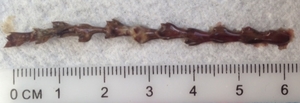Hollybank’s Brave Pet of the Month…Bear!
 Bear is a lovely male Chesapeake Bay retriever who recently presented to Hollybank Veterinary centre with a sudden onset cough.
Bear is a lovely male Chesapeake Bay retriever who recently presented to Hollybank Veterinary centre with a sudden onset cough.
When an animal presents with a cough it is important to know how quickly the cough developed, the severity and frequency of the cough and what the cough sounds like.
Other specific clinical signs that we may ask about include: sneezing, nasal discharge, breathing rhythm and effort and willingness and ability to exercise as normal.
There are lots of reasons for a coughing dog. This can include, kennel cough, infectious pneumonia, aspiration pneumonia/aspirated foreign material, heart disease, lungworm, bronchitis, cancer, fluid, air or infected fluid within the chest cavity.
In our physical exam we want to pay particular attention to the respiratory tract. Your animal’s windpipe will be palpated to assess whether they are sore or reactive in this region i.e can we stimulate a cough. The lungs will be listened to for abnormal lung sounds which can include; crackles, rattles, whistles and wheezes. Your animal’s respiration rate, rhythm and effort will also be noted. Heart disease can actually present with a cough so ruling in or out a heart murmur is helpful too. Regardless of the complaint a full physical exam will be performed too.
On Bear’s physical examination there was some mild irritation along his windpipe but he was otherwise very well. We elected to monitor bear in the first instance. Often cases of mild tracheal irritation or kennel cough will resolve without intervention given time.
However, due to the quick development of his cough and the reaction around his windpipe we could not rule out trauma and inhalation of a foreign body. If Bear’s cough failed to resolve we would need to re-examine him with the proposal for further investigations.
 Within 4 days Bear’s cough had still not improved. To investigate further we would need to take chest x-rays to image Bears lungs and the space around them. A small camera would also need to be placed down his large airways, a procedure called bronchoscopy.
Within 4 days Bear’s cough had still not improved. To investigate further we would need to take chest x-rays to image Bears lungs and the space around them. A small camera would also need to be placed down his large airways, a procedure called bronchoscopy.
On bronchoscopy, a large sprig of hedgerow was found lodged in Bear’s bronchus. The foreign material was removed under camera guidance and specialised forceps.
 As you can see the size was quiet considerable!
As you can see the size was quiet considerable!
Bear was sent home to recover on a short course of oral antibiotics. Bear was still expected to cough within the first few days due to a combination of disruption of the airway lining (which activates cough receptors) and residual inflammation and infection.
Bear is currently doing very well at home and hasn’t had any further fights with any hedgerows!
